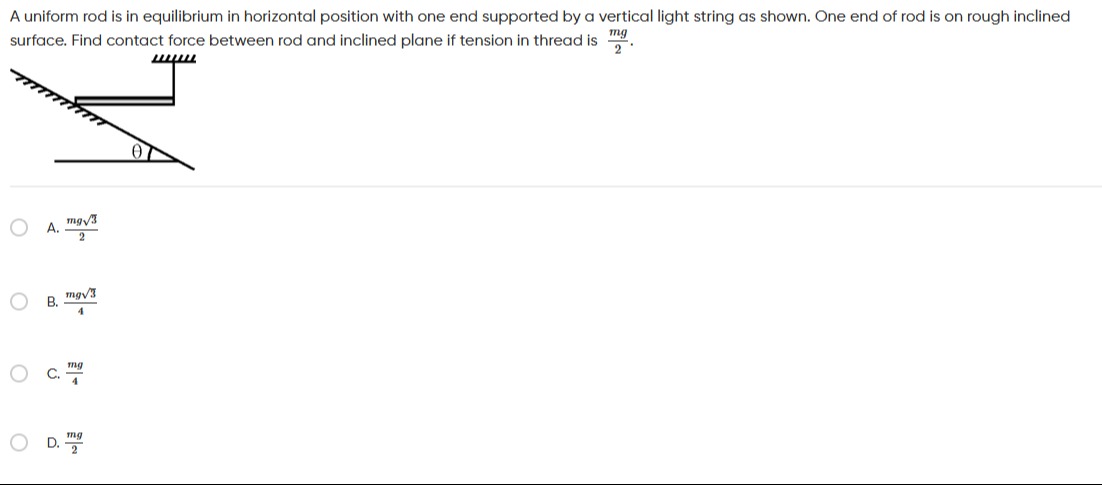Question
Question: A uniform rod is in equilibrium in horizontal position with one end supported by a vertical light st...
A uniform rod is in equilibrium in horizontal position with one end supported by a vertical light string as shown. One end of rod is on rough inclined surface. Find contact force between rod and inclined plane if tension in thread is 2mg.

2mg3
4mg3
4mg
2mg
2mg
Solution
The rod is uniform and in equilibrium in a horizontal position. Let the mass of the rod be m and its length be L. The weight mg acts at the center of the rod. The rod is supported by a vertical string at one end (let's call it B) with tension T=2mg, and the other end (let's call it A) rests on a rough inclined surface. Let the angle of inclination of the surface with the horizontal be θ.
The forces acting on the rod are:
- Weight mg acting vertically downwards at the center of the rod.
- Tension T acting vertically upwards at end B.
- Contact force at end A, which can be resolved into a normal force N perpendicular to the inclined plane and a frictional force f parallel to the inclined plane.
We analyze the equilibrium of the rod. Let's resolve all forces into horizontal and vertical components. We set up a coordinate system with the x-axis horizontal and the y-axis vertical.
The weight vector is W=(0,−mg). The tension vector is T=(0,T)=(0,2mg).
The inclined plane makes an angle θ with the horizontal. The normal force N is perpendicular to the inclined plane. Assuming the inclined plane is tilted upwards to the right, the normal force acts upwards and to the left. Its components are: N=(−Nsinθ,Ncosθ).
The frictional force f is parallel to the inclined plane. For equilibrium, let's assume it acts up the incline, i.e., to the right and upwards. Its components are: f=(fcosθ,fsinθ).
For translational equilibrium, the sum of forces in the horizontal and vertical directions must be zero.
Horizontal equilibrium: fcosθ−Nsinθ=0⟹f=Ntanθ.
Vertical equilibrium: Ncosθ+fsinθ+T−mg=0. Substitute T=2mg and f=Ntanθ: Ncosθ+(Ntanθ)sinθ+2mg−mg=0 Ncosθ+Ncosθsin2θ=mg−2mg N(cosθcos2θ+sin2θ)=2mg N(cosθ1)=2mg N=2mgcosθ.
Now, we find the frictional force: f=Ntanθ=(2mgcosθ)tanθ=2mgsinθ.
The contact force between the rod and the inclined plane is the vector sum of the normal force N and the frictional force f. The magnitude of the contact force, Fc, is given by: Fc=N2+f2 Fc=(2mgcosθ)2+(2mgsinθ)2 Fc=(2mg)2(cos2θ+sin2θ) Fc=(2mg)2×1 Fc=2mg.
The magnitude of the contact force is 2mg, which is independent of the angle θ.
